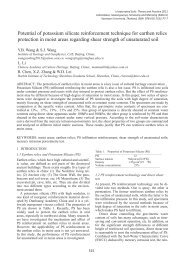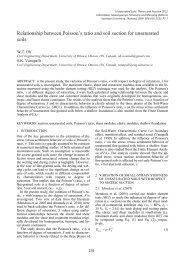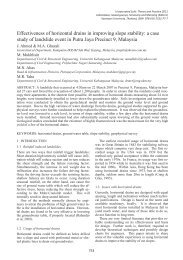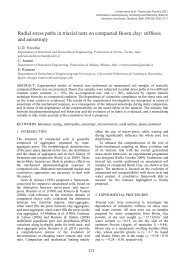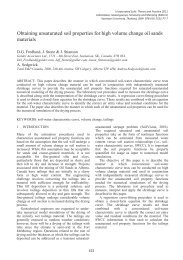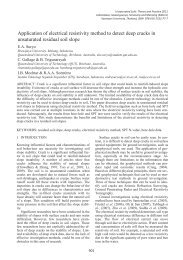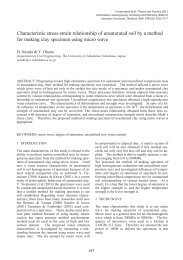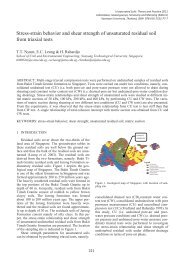Mechanisms of longitudinal cracks along pavement shoulder in ...
Mechanisms of longitudinal cracks along pavement shoulder in ...
Mechanisms of longitudinal cracks along pavement shoulder in ...
- No tags were found...
You also want an ePaper? Increase the reach of your titles
YUMPU automatically turns print PDFs into web optimized ePapers that Google loves.
In this paper, unsaturated soil mechanics will beused to expla<strong>in</strong> such mechanism <strong>of</strong> <strong>cracks</strong> <strong>along</strong>highway <strong>shoulder</strong>, <strong>in</strong>volv<strong>in</strong>g shr<strong>in</strong>k-swell clay subgrade,<strong>in</strong> central Thailand. Influence <strong>of</strong> dry<strong>in</strong>g on<strong>in</strong>itiation <strong>of</strong> <strong>cracks</strong> will be explored based on seepageand deformation analyses. The fully saturatedand unsaturated shear strength parameters are usedto determ<strong>in</strong>e the stability <strong>of</strong> slope which exacerbatedby water <strong>in</strong>filtration, and strength s<strong>of</strong>ten<strong>in</strong>g.Table __________________________________________________1. Summary <strong>of</strong> subgrade properties at the test site T1Specific LL PL PI Wn γ d SPTGravity, % % % % t/m 3 Blow/ftGs __________________________________________________2.71 43-53 17-21 26-34 20-27 1.49- 101.69LL = Liquid limit, PL = Plastic Limit, PI = Plasticity Index,Wn = Natural water content, sampled on 13-16 August 2009(dur<strong>in</strong>g ra<strong>in</strong>y season), γ d = Dry density, SPT (uncorrected)2 TEST SITE2.1 Highway route 357Highway route no. 357 (Suparnburi by-pass) located<strong>in</strong> Suparnburi prov<strong>in</strong>ce, central region <strong>of</strong> Thailandwas selected as the test site where severe <strong>longitud<strong>in</strong>al</strong>crack<strong>in</strong>g <strong>along</strong> asphalt <strong>pavement</strong> <strong>shoulder</strong> wasencountered prior to traffick<strong>in</strong>g. The test sites consisted<strong>of</strong> two adjacent sections: one section hav<strong>in</strong>gsevere <strong>cracks</strong> (sta. 32+600 to sta. 33+100) designatedas T-1 and another hav<strong>in</strong>g m<strong>in</strong>or <strong>cracks</strong> (sta.31+600 to sta.32+100) designated as T-2. This paperhowever focuses on the section T-1 only.2.2 Field <strong>in</strong>vestigation and basic propertiesAn extensive field <strong>in</strong>vestigation programme (<strong>in</strong>clud<strong>in</strong>gborehole/test pits sampl<strong>in</strong>g, field vane shear,SPT, Kunzelstab penetration tests) revealed that thefoundation soil consists <strong>of</strong> stiff clay and very stiffclay to the depth <strong>of</strong> 5.5 metres below which existsthe medium-dense to dense sand. The subgrade materialis classified as a medium-to-high plasticityclay (CL-CH) with thickness <strong>of</strong> about 2m. Its basicproperties are summarized <strong>in</strong> Table 1. The soil mapfrom Department <strong>of</strong> Land Development (used foragricultural purpose) also <strong>in</strong>dicated that Vertisol existed<strong>in</strong> shallow depth around the vic<strong>in</strong>ity <strong>of</strong> thehighway. The depth <strong>of</strong> <strong>cracks</strong> at Site T1 (Figure 1)appeared to be at least 48 cm and the <strong>longitud<strong>in</strong>al</strong>length varied from 2.3 to 90 metres.The maximum dry density, γ dmax , from modifiedProctor tests was 1.74 t/m 3 and the optimum moisturecontent, OMC, was 13.3%. Therefore, the percentcompaction is 86-97% and the soil, especiallyclose to surface, must have wetted up from its ascompactedstate and perhaps have expanded. Detailedsound<strong>in</strong>g tests us<strong>in</strong>g Kunzelstab light weightpenetrometer <strong>along</strong> the slope <strong>of</strong> embankment <strong>in</strong>dicatesthat the s<strong>of</strong>t zone ran sub-parallel to the slopeand down to depth <strong>of</strong> 0.5 to 1 metre, as shown <strong>in</strong>Figure 3. The <strong>cracks</strong> thus seemed to be associatedwith shallow movement.0 0.5 1 1.5 2 2.5 3 3.5 4 4.5 5 5.50-0.5-1-1.5Distance, m-2Depth, m-2.5-3-3.5-4-4.5-5Figure 2. A typical cross-section <strong>of</strong> the test section.This highway consists <strong>of</strong> two carriage lanes <strong>in</strong>each direction. The carriage lanes were constructedus<strong>in</strong>g the concrete <strong>pavement</strong>, while the <strong>shoulder</strong>swere constructed us<strong>in</strong>g the asphalt <strong>pavement</strong>. Thewidths <strong>of</strong> <strong>in</strong>ner and outer <strong>shoulder</strong>s are 1.5 and 2.5m, respectively. The side slope is about 2 horizontalto 1 vertical (2:1) and covered with grass on bothsides <strong>of</strong> the slopes. Figure 2 illustrates a typicalcross-section <strong>of</strong> the test section.-5.50 5 10 15 20 25 30 35 40 45 50Figure 3. Blow counts (per 20cm) <strong>of</strong> Kunzelstab tests <strong>along</strong>embankment slope (a light weight dynamic penetrometer, withweight <strong>of</strong> 10kg, and a fall<strong>in</strong>g height <strong>of</strong> 0.5metre)Pore-water pressure distribution <strong>in</strong> the slope wasmonitored at five locations <strong>along</strong> the slope cross sectionus<strong>in</strong>g Kasetsart University (KU)-made tensiometersas <strong>in</strong>stalled by Jotisankasa et al. (2010)approach. Figure 4 shows the pore water pressureand total hydraulic head <strong>in</strong> October 2009, close tothe end <strong>of</strong> ra<strong>in</strong>y season <strong>in</strong> that year. It can be seen700



